Acne-like rashes on the shoulders and forearms have become a common occurrence for many people. Inflammations not only look unattractive, but also indicate malfunctions of the body or serious illnesses. Ignoring the problem can result in an even greater spread of rashes to other parts of the body. To prevent this from happening, it is worth understanding the reasons and choosing the right therapy.
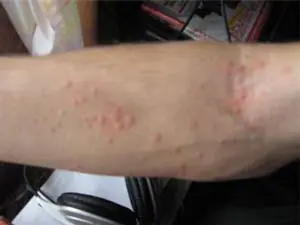
There are six types of rashes, which have different colors and may change in the future.
- Stains. Markings with a characteristic light pink or purple color.
- Nodules. A rash on the forearms in the form of small pimples or clearly defined tubercles. Cause pain on palpation.
- Bubbles. They resemble semicircles of different sizes containing liquid. Subsequently they disappear.
- Blackheads or acne. Appear as a result of inflammation of the sebaceous glands. They come in black and milky white. With age they disappear or transform into nodules.
- Ulcers. Pimples that grow in the upper layers of the epidermis. Pus appears in each cavity. The skin around the lesion turns red and the inflammation itches.
- Vesicles or blisters. They look like dense cavities that are filled with contents of various shades. After treatment, noticeable scars are left.
Factors of occurrence

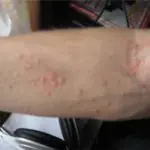
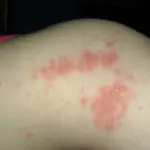
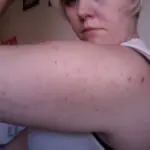
The causes of rashes are varied. They are divided into three groups - infectious, internal non-infectious, external.
The first category includes: lichen, syphilis, viral diseases such as measles, rubella, chicken pox or herpes.
The second is characterized by: imbalance of microflora, diseases of the thyroid gland and blood vessels, malfunctions of the genitourinary system, and liver damage. Also, adolescents during puberty and pregnant women experience hormonal imbalances that provoke the appearance of acne.
The list of external factors is extensive. What could it be:
- Violation of personal hygiene rules.
- Squeezing pimples provokes infection and inflammation of comedones.
- Abuse of alcohol, tobacco and unhealthy food, which directly affects the condition of the skin.
- Lack of vitamins and minerals interferes with the proper function of organs.
- Stressful situations provoke intense production of hormones that are responsible for the sebaceous glands.
- The use of some cosmetic procedures causes irritation in the form of red dots.
- Excessive sweating caused by physical exertion and hot weather.
- Prolonged exposure to ultraviolet rays.
- Wearing tight, tight, or synthetic clothing makes it difficult for the skin to breathe and creates friction between the fabric and the upper layer of the epidermis.
- The presence of a mental disorder, which manifests itself in the form of involuntary itching.
- Taking medications for a long time.
- Exposure to allergens such as food, plants and animals, household chemicals, etc.
- Long hair makes it difficult for the skin to breathe.
Another reason for formations is a genetic predisposition, which often manifests itself in an infant in the first year of life.
Therapy
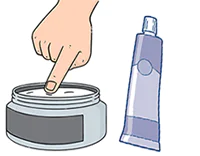
Excessive rashes on the back and shoulders are often harbingers of a destructive state of the body. Therefore, if a rash occurs, you should consult a dermatologist. After passing the necessary tests, the doctor will determine the nature of the disease and prescribe treatment. Complex therapy is the interaction of drugs for external and internal use that destroy the causes of the disease.
As has already been said, “the occurrence of pathological inflamed areas of the skin has a different etymology, therefore the therapy should be different.”
To improve the condition of the epidermis, the doctor prescribes ointments and gels, including:
- "Dalacin" is an antibiotic suitable for eliminating ulcers and redness from large areas of the body. However, the drug has a number of contraindications, and uncontrolled use is fraught with the appearance of scars after long-term use.
- Skinoren has an anti-inflammatory effect and removes skin redness.
- "Curiosin" is an antimicrobial agent that promotes tissue healing. Used to get rid of acne and purulent pimples.
- Vishnevsky ointment is suitable for healing wounds and infections, eliminates inflammation.
- Zinc is a time-tested drug with universal properties. Used to treat rashes in adults and children.
- Salicylic acid normalizes the functioning of the sebaceous glands, regenerates and cleanses.
- Metrogyl destroys infections caused by microorganisms.
- “Badyaga”, due to its irritating effect, increases blood circulation, which promotes skin renewal. In addition, it cleanses the epithelium. It is used as an independent remedy or in combination with other drugs, enhancing their effect. It is not recommended to use in case of violations of the integrity of the skin and open wounds.
Despite their advantages, external medications, when used for a long time, can cause allergic reactions in both children and adults. Therefore, consultation with a doctor is mandatory.
Vitamin complexes help normalize the condition of tissues. “Aevit”, “Pentovit”, “Aerovit”, “Vitaminel” are well suited for this. The course is one month.
In case of allergies, irritation is relieved by taking Suprastin, Diazolin, Tavegil or other antihistamines.
For internal reasons, the specialist prescribes immunomodulators and hormonal agents. Treatment lasts for several months. Sometimes the disease does not go away without a trace, but only subsides for a while.
Baths based on medicinal herbs serve as concomitant therapy to pharmacological drugs. Decoctions of chamomile, celandine, yarrow, and string will help dry the skin. Compresses made from infusion of sage and birch buds will significantly reduce the appearance of acne. Plantain infusion is known for its disinfecting and anti-inflammatory properties.
It is necessary to prepare the body before and after using baths or compresses. Before use, wash off any remaining ointments or gel, and at the end of the procedure, pat the skin dry with a soft towel or napkin.
Prevention
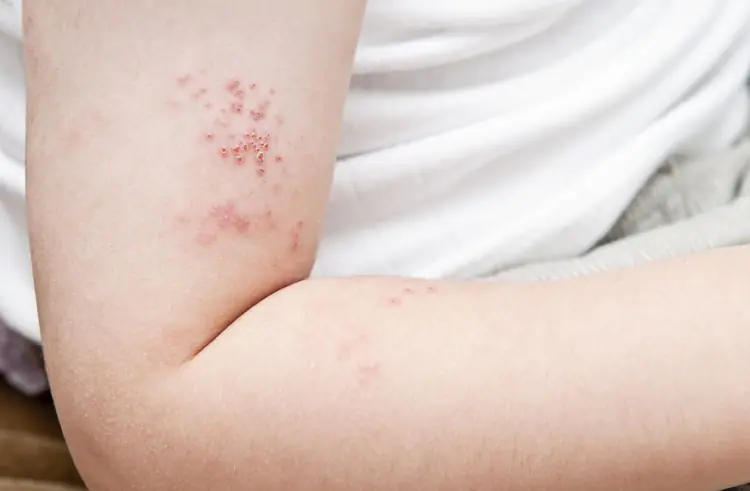
It is enough to follow simple rules so that an existence without itching and inflammation becomes the norm. A healthy lifestyle has never harmed anyone, so it is worth excluding foods with artificial colors, flavors, and preservatives from your diet. Do not eat overcooked, spicy foods.
Use natural cosmetics. Remove clothes made from synthetic fabrics from your wardrobe. Quit alcohol and smoking. Pay attention to personal hygiene.
Change bedding every 1-2 weeks, do not use someone else's underwear. In addition, avoid stress and anxiety, since most diseases are associated with instability of the human central nervous system.
Conclusion
A rash on the shoulders and forearms is a rather unpleasant phenomenon that has internal and external causes. And if the former are sometimes difficult to get rid of, the latter can be avoided if certain conditions are met.
The problem of acne on the shoulders has, to one degree or another, affected most of the population of our entire planet.
Rashes can appear in a person of any age and gender. Pimples are not only unsightly, but can also indicate serious illnesses.
It is worth taking your health seriously and understanding the causes of such a problem as a rash on your back and shoulders.
Types of acne that can appear on the shoulders
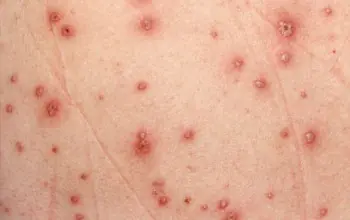
It reflects on the skin in the form of a watery rash. Small pimples often appear initially on the face, but can also affect the shoulders.
This disease occurs with a very high body temperature and other symptoms similar to those of the flu - runny nose, cough, weakness.
Chickenpox
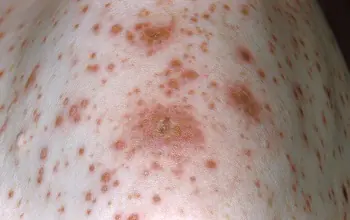
With chickenpox red pimples appear in the upper back, on the shoulders, on the neck.
Subsequently, the rashes spread throughout almost the entire body. They are accompanied by itching.
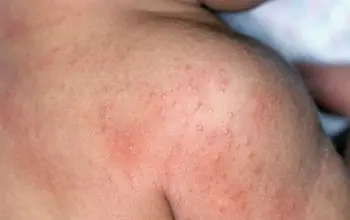
These pimples are very large and are located on random parts of the body.
The rash causes severe itching.
But the hives disappear quite quickly - in three to four days - so the disease does not pose any particular danger.
Cystic acne
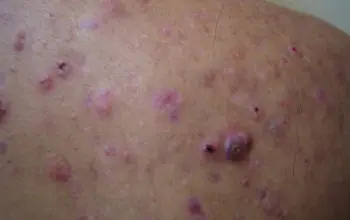
This rash is caused by deep subcutaneous infection.
The disease is accompanied by the appearance of dark, dense spots on the back and shoulders, as well as large pimples filled with pus.
Acne
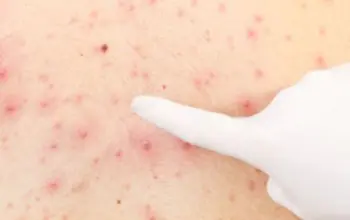
First, comedones appear on the skin.
Later they become infected and inflamed, which leads to the appearance of very large, sometimes even purulent pimples.
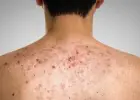
We also advise you to study information about the features of treating acne in an adult: cleansers, creams and lotions, diet.
And if the first four types of acne disappear when treated for the corresponding disease, then acne requires a special approach. And in order to fully get rid of such a problem, it is worth thoroughly studying the reasons for its occurrence.
Causes of acne on shoulders
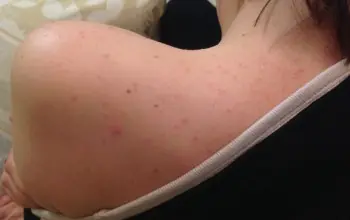
Properly functioning glands make our skin well-groomed and smooth, but excess sebum clogs into the pores and causes inflammation.
But what causes such deviations in functioning?
Let's divide the causes of acne on the shoulders and back into external and internal.
External
- Wearing synthetic clothing. Such materials do not allow the skin to breathe, and also do not absorb sweat, which causes clogging of pores.
- Wearing clothes that are too tight. In this case, as when wearing synthetics, the skin’s breathing is difficult. Also in this case, the rash can be caused by excessive friction of clothing against the skin.
- Allergic reactions. The modern world is replete with various not entirely useful substances - this can be food, certain medicines, and cosmetic products. It is necessary to carefully monitor the effect of certain products on the body and, in case of any changes, respond promptly.
- Bad habits. Smoking and drinking alcohol undoubtedly leaves its detrimental mark on the condition of the skin. Bad habits also include unhealthy eating - fast food, sugary carbonated drinks, eating too fatty or too spicy foods.
- Lack of vitamins. It is vitamin deficiency that complicates the functioning of all organs, including the skin.
- Stress. Various nervous tensions increase the production of hormones that are responsible for the functioning of the sebaceous glands.
- Long hair They can also make it difficult for the skin to breathe properly and cause acne to appear on the shoulders.
- Peeling. This cosmetic procedure can destroy the upper protective layer of the epidermis and provoke various rashes.
- Excessive amount of ultraviolet radiation. Excessive exposure to the sun is also detrimental to your skin.
- Failure to comply with hygiene rules.
- Squeezing pimples. Unfortunately, this kind of error is very common. Such actions can lead to infection of comedones and their inflammation.
Internal reasons
- Puberty. During puberty, there is an active production of hormones that can cause skin problems.
- Pregnancy or post-abortion period. Such events are also accompanied by changes in hormonal levels.
- Diseases of the gastrointestinal tract, dysbacteriosis.
- Diseases of the endocrine system, in particular the thyroid gland.
- Liver diseases.
- Disorders of the genitourinary system.

A detailed description of the causes and mechanisms of formation, types and degrees of acne is here.
Did you get acne during pregnancy? The main thing is not to panic or get upset, because this is a temporary phenomenon.
How to get rid of acne on shoulders?

It is necessary to go to the hospital in a timely manner to avoid progression of the disease.
In addition to a visual examination, the following studies may be prescribed by a dermatologist:
- blood analysis;
- examination for dysbacteriosis;
- Ultrasound of the gastrointestinal tract;
- hormone analysis.
Based on the results of the research, the attending physician will prescribe a course of necessary medications. This includes antimicrobial, anti-inflammatory drugs.
Ozone therapy, a course of microcurrent therapy or darsonvalization are also prescribed.
In severe cases, immunomodulators and hormones are used.
You should also perform the following simple procedures at home:
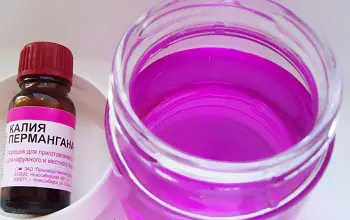
After just a few days of such procedures, visible results are noticeable.
You can also take baths with this solution. There must be water light pink colorOtherwise, the skin may become stained and dry out too much.
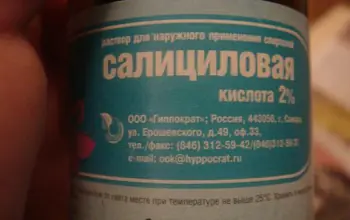
Application may cause some burning, but it is quite tolerable.
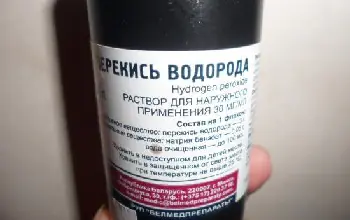
- Rubbing painful areas alcohol tincture of calendula.
- Washing with tar soap. It will dry out inflammation.
- Washing with a hard sponge. This massage will increase blood flow to the skin.
- Taking a bath with sea salt, decoctions of chamomile, calendula, celandine, string.
- Using masks from clay or algae with the addition of a few drops of tea tree essential oil.
- A course of multivitamins and brewer's yeast.
- Diet.
What you should categorically avoid if acne appears on your shoulders:
- Wearing clothes made of synthetic materials. Give preference to natural fabrics - knitwear, cotton, satin.
- Wearing clothes that are too tight. Buy loose models in which the skin can fully breathe.
- Use of massage oils. They can cause clogged pores.
- Active solar procedures. Ultraviolet light in small doses is very beneficial for the skin and is even used to treat acne, but its excess amount is harmful.
- Using washcloths made of artificial materials.
- Use one towel for face and body.
- Eating junk food.
Prevention
To maintain healthy skin, you should adhere to the rules of a rational, healthy diet. It would also be appropriate to give up bad habits. Tar soap and decoctions of various herbs should become constant companions of water procedures.
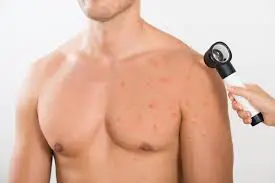
For many young girls and boys, and even older women and men, suffering from acne and rashes, acne is localized not only on the face. One of the many places of such localization is acne in the forearm, the causes and treatment of which we will discuss today Let's talk.
To get rid of such a problem, it is important to first find out what causes acne on the forearm, the causes of which are often simply a violation of some hygiene rules, or even in more serious cases, diseases of internal organs and disruption of their functions.
What causes a rash on the forearm in the form of small pimples?
All factors leading to the progression of acne rashes on the forearm can be divided into internal and external.
The first group includes:
- Digestive diseases and unhealthy diet;
- Endocrine disorders of hormonal production, both general and hormonal;
- Infectious skin lesions;
- Allergic reactions of the immune system to contact with histamines;
- Excessive alcohol consumption, smoking;
- Subcutaneous mite (demodex);
- Lack of vitamins and nutrients in the body.
It is possible to determine exactly one of the causes of these pathologies only after a series of tests, and if it turns out that acne on the forearm appeared for one of these reasons, you must first seek treatment for the primary disease, and then carry out acne therapy. Rashes in such cases are not considered independent diseases, but are considered a clinical manifestation. As a rule, after successful treatment of the underlying cause of acne, they disappear almost completely and permanently.
External causes of acne on shoulders
External causes include those factors that quickly disappear after changes in external influences on the skin.
The appearance of red or white pimples in the forearm area may be influenced by the following factors:
- Excessive ultraviolet radiation can have a negative impact on your skin if you take too much sunbathing and are exposed to the sun for more than 8 hours a day.
- Taking steroid drugs Drugs from this series are used in the treatment of kidneys and the immune system, which interfere with the normal functioning of the sebaceous glands.
- Using low-quality or unsuitable cosmetics for your skin type. Preference should be given to organic products designated as “organic cosmetics”.
- Mechanical damage such as cuts, abrasions, wounds.
- Wearing clothes made from artificial fabrics Synthetics prevent the skin from breathing, causing blockage of the sebaceous glands and the formation of comedones, which can subsequently become inflamed due to infection.
- Impact of stress and lack of sleep Insufficient time for rest and psycho-emotional overload negatively affects the regeneration processes of the epidermis and reduces the local immunity of the skin.
What is the difference between pimples and small rashes on the forearm?
First, the similarities: Pimples and small rashes can occur when your pores become clogged and irritated.
But acne, which is much more common around the world, develops when dirt or dead skin cells enter the oil duct of a pore, says Bruce Robinson, MD, a New York City dermatologist and fellow of the American Academy of Dermatology.
Bacteria become trapped in the canal, causing irritation and inflammation, making the pimple red and inflamed.
(A rash of small pimples, also considered blackheads, is simply trapped dirt or dead skin cells without any bacteria or inflammation.)
On the other hand, a small rash on the forearm is formed when the sweat from the pores gets clogged with excessive amounts of sweat, forming small clear or red bumps that resemble a rash.
Dr. Robinson states that deeper blockages become inflamed, making forearm pimples red and inflamed. This inflammation can also make some feel itchy or prickly in nature.
Pimples are also often filled with white pus in the center of the pimple, and you may get several similar breakouts in this area of the forearm.
Why do you get pimples or small red rashes after working out?
Producing copious amounts of sweat is a major trigger for acne and red or white pimples. The more you sweat, the more likely it is that dirt or dead skin cells or sweat can clog your pores and cause acne inflammation, says Dr. Robinson.
Exercising in a humid environment can increase your risk of acne breakouts even more, as high humidity makes it difficult for sweat to evaporate from your skin.
Therefore, change your sweaty T-shirt immediately after training and do not delay taking a shower.
How can you prevent acne on your forearm?
Neither a pimple nor a heat rash are harmful or severely inflammatory for the skin, and both usually go away on their own within a few days, says Dr. Robinson. If they don't bother you, or you want to try a new treatment, you don't need to see a dermatologist.
But they can be ugly and irritating, especially if your pimple is sensitive or tender, or your heat rash is itchy.
Try swapping out a damp T-shirt for a new one periodically during your workout, recommends Dr. Robinson.
This will rid your forearm skin of a lot of sweat, dirt build-up on the surface of your skin, so it can't clog your pores and cause breakouts or heat rashes.
Dr. Robinson says you should remove your wet T-shirt as soon as you finish your workout, and don't wait until later to shower to prevent dirt or sweat from getting into your pores.
Take periodic breaks if you exercise in the heat or in a hot, humid environment such as a gym.
How can you treat pimples and small rashes on your forearm?
If you notice blemishes appearing after your workout, using acne and rash products containing ingredients like benzoyl peroxide or salicylic acid may help after your workout session, says Dr. Robinson.
Look for types that contain 2% salicylic acid or 5 to 10% benzoyl peroxide.
But talk to your dermatologist before using them, as they can irritate your skin if used incorrectly, says Dr. Robinson.
As for sweat pimple rashes, there is nothing you can do to make the spots disappear sooner. But if they itch, try using an anti-itch cream or lotion that contains cooling ingredients such as menthol and camphor, or a cream containing 1 percent hydrocortisone.
This should help relieve the itching and make your rash feel better.
By all means, see a dermatologist if you notice any pain or swelling, or if your heat rash has pus, as these symptoms could be signs of a more serious infection.



